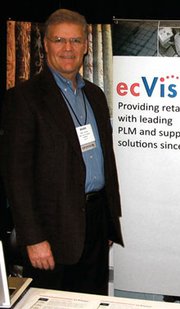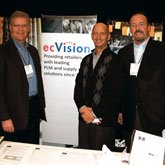IT Suppliers Urge Retailers, Brands to Continue Tech Investments
NEW YORK—Technology vendors convening Nov. 5–6 for the annual Apparel Tech Conference at the Fashion Institute of Technology here warned visiting apparel brands and retailers that they could lose a step in business if they halt or delay their technology investments as a result of the sagging economy.
Fears of the sagging economy’s impact on technology investments were prevalent at the two-day conference and expo, which covered topics ranging from PLM (product lifecycle management) to design and RFID (radio-frequency identification). As big national retailers continue to close stores and manufacturers look to downsize, their technology suppliers did their best to show how technology may enhance their balance sheets going forward. Hot categories such as PLM have buoyed sales for many providers over the past 18 months, including Miami Lakes, Fla.–based New Generation Computing.
“When there is an uptick in the economy, you want to be positioned to gain business right away,” said Mark Burstein, vice president of PLM and global sourcing for NGC. Burstein presented a workshop on PLM and sourcing management, explaining how integrating various applications can help companies become more efficient. PLM manages all steps of pre-production via the Internet. Sourcing applications such as NGC’s e-SPS have also been gaining favor.
“Many of the analysts are pointing to sourcing as an extension of PLM,” Burstein said.
At the event’s expo, featuring top equipment and software providers, representatives said they are starting to see how the economy is affecting their businesses as well as their customers’.
Kristine Gloviak of Los Angeles–based CAD provider PAD System/GCL said her customers that contract with stores such as Wal-Mart are adding stations, yet others that work for higher-end chains are downsizing.
“The middle is getting squeezed,” said Paul Magel, senior vice president of New York–based Computer Generated Solutions, which develops Blue Cherry software. “A lot of companies are doing well, however.”
CGS executives gave a presentation on the company’s business-intelligence software, which provides visibility into key performance indicators such as profits, sales and volume, inventories, accounts receivables, and shipped goods.
Magel said one of the keys to doing business in the current economic climate is providing value. “You have to take flexibility to the next level and implement faster with less money,” he said.
Of the two dozen workshops presented, the common denominator was the bottom line. The challenge was persuading companies to look beyond sometimes big upfront investments, and that is difficult to do right now, said technology executives.
“Salespersons always call with a statement of ’I can save you money.’ The message should be ’Let me show you how you can make money,’” said Yoram Burg, president of CAD provider OptiTex USA, who presented a session on using 3-D for pattern-making and design. “That’s what we are about.”
Added Ray Hein of Campbell, Calif.–based PLM provider Centric Software: “Simple cost-cutting does not equal leadership. More importantly, simple cost-cutting does not even equal survival.”
Citing research from the McKinsey Quarterly, Hein said turning off technology investments during a downturn is counterproductive. “When business picks up again, you may lack critical capabilities.”’Retail Technology 2.0’
Analyst Janet Suleski of AMR Research emphasized the need for technology during her keynote address on retailing.
“We need to use technology to get to know our customers. You can’t see everything in your databases,” she said. Suleski pointed out that a retail brand shakeout is overdue and the stores that employ the proper technology tools will be better positioned. “You have to put better technology in the hands of store managers and associates. It drives me crazy when one store looks like another.”
She illustrated this using her own shopping habits. She recently visited a leading specialty chain and spent a significant amount of money on apparel.
“I left there never to hear from that retailer again,” she said. “They dropped the ball.”
One way of gaining business intelligence is through cross-channel marketing, using much of the Web 2.0 technology such as Live Journal, Facebook and Delicious.com available free to retailers. About 80 percent of buying decisions made by consumers are done in store, and with the advancement in consumer electronics technology, consumers are changing their shopping methods, using iPhones and other handheld devices, Suleski said.
“A lot of the information gets stuck in marketing. Where else can you use it?” She pointed out that consumer electronics retailer Best Buy uses Web sites such as Twitter (www.twitter.com) to track consumer behavior, and some entire back-office systems will be on Twitter within three years. It’s already happening in India, where Nokia manages its 240 agents through Twitter.
Orange County, Calif.–based retailer Wet Seal is piloting a project that features interactive kiosks placed in dressing rooms, enabling customers to get input on outfits from Wet Seal’s 30,000-member digital community.
Suleski said that by 2010, retail technology may not even resemble what it did two years ago. Visual merchandising using 3-D tools should be more common in 2011, she said. By then, more than 60 percent of stores should have cross-channel merchandising and marketing plans in place. About half of online retailers will be on third-generation e-commerce systems.
California-based technology resources such as Malibu-based Shapely Shadow and Los Angeles–based Tukatech Inc. gave demonstrations of 3-D and visual display systems. Shapely Shadow officially debuted its FastFit360 system, which uses high-speed digital photography to capture finished samples in one file, allowing designers and factories to collaborate on fit. The software enables users to rotate a sample on a fit model or form in circles and make necessary adjustments.3-D e-fit advance
Company principal Roxy Starr said the system has proven to reduce sample-approval times by 50 percent as well as reduce the time needed for fit models and other fees by as much as 50 percent.
“Everybody is cutting their travel budgets in 2009, so this can help,” she said.
Tukatech Chief Executive Officer Ram Sareen’s presentation on CAD and 3-D prototyping provided demos on the company’s suite of products, including 3-D-based dress forms, CAD and a new marker system, which Sareen claimed in industrial applications can create zero waste. He showed how all the information can be exported into the company’s e-fit simulator application, which can drape a virtual sample over an animated 3-D avatar that moves to show fabric constriction and other problem areas. Some of the company’s customers are creating finished products without having to create a physical sample and even collaborating on production using the 3-D representations over Apple’s iPhone.
OptiTex’s Julia Shaw also showed a 3-D animated system, which she said has helped some of the country’s leading sports and fitness companies run virtual fittings for those companies’ top athletes. OptiTex now has an animation plug-in from Maya Technologies, which has worked with Pixar/Disney on several projects.
Shaw said by partnering with technology companies such as Nvidia, it has also been able to improve speed on its applications.American Apparel and RFID
And in another example of how technology is helping companies save money, Thomas Racette of Motorola outlined how the company is helping Los Angeles manufacturer/retailer American Apparel implement RFID in its stores. Racette said American Apparel has been able to achieve stellar results using the emerging technology, which uses chips embedded in bar-coded tags that are read by wireless scanners.
“Each tag is like a license-plate number. The difference is that with normal barcodes, you have the same number for each style of shirt or whatever [item]. With RFID, you have a different number for each shirt,” he explained.
American Apparel has been able to reduce inventory counts from 36 hours to five and achieve 99 percent accuracy read rates. As a result, the company reduced out-of-stocks by as much as 90 percent in a pilot test in New York. Other chains such as Wal-Mart have reduced out-of-stocks by 16 percent.
“It’s time to stop piloting and begin using [RFID],” Racette said.
The costs have certainly come down. Tag prices are now 8 to 12 cents, down from 15 to 25 cents a couple of years ago.Campbell, KidRobot among the All-Stars
The Apparel Tech Conference is hosted by Apparel magazine, which also bestows its annual All-Star Awards at the event.
This year, Los Angeles–based manufacturer Knit Works and retailer KidRobot were among the winners at the event, held Nov. 5 at FIT.
The awards are given to individuals and companies that display outstanding business practices in the area of innovation, leadership, technology and philanthropy.
Knit Works KWDZ Inc., owned and operated by Vera Campbell, is a knitwear manufacturer for the tweens marketplace and provides branded and private-label apparel for Tween Brands (Limited Too), JCPenney, Kohl’s, Macy’s, Bon-Ton, Nordstrom and others. The company, nominated by the California Fashion Association, was singled out for its ability to create “fast fashion” from concept to finish in eight to 12 weeks. It was also noted for its solid relationship with its stores. Campbell credited the company’s veteran sales team for its consistently strong performance. Many of its sales executives have been with the company for up to 25 years. Campbell also gives back to the Los Angeles community. She is on the board of Inner City Arts, a Los Angeles nonprofit that provides arts education for inner-city students, and she sits on the board of Junior Blind of America.
New York–based retailer KidRobot, which has stores in Los Angeles, San Francisco and Miami, was noted for growing a niche by producing one-of-a-kind clothing and toy items that can command prices into the thousands. Other award winners included footwear company New Balance, sportswear brand Antigua Group, swimwear maker Karla Colletto, intimate-apparel company Ariela Alpha, Klim USA, Wells Hosiery and Vineyard Vines.

























